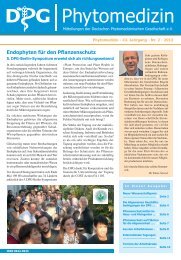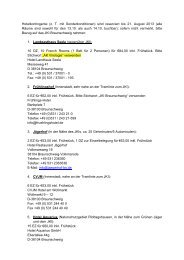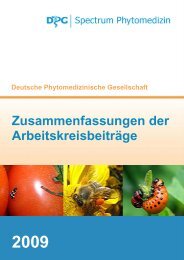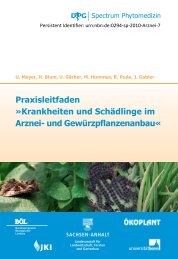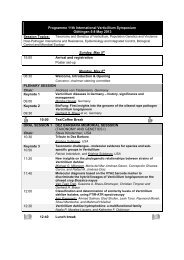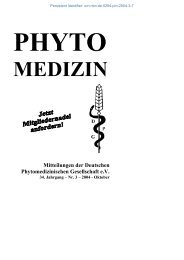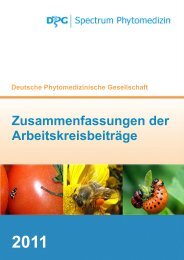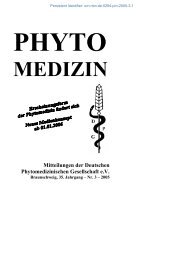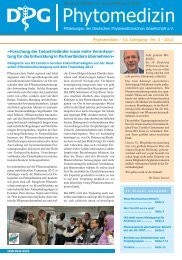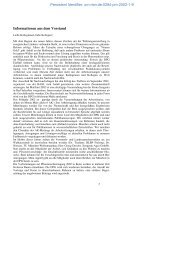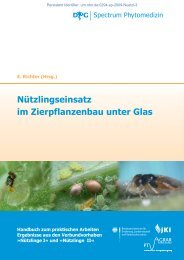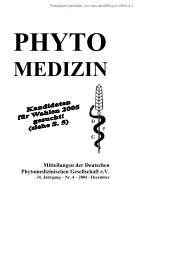fourth joint meeting of dutch and german
fourth joint meeting of dutch and german
fourth joint meeting of dutch and german
You also want an ePaper? Increase the reach of your titles
YUMPU automatically turns print PDFs into web optimized ePapers that Google loves.
Multiple infections <strong>of</strong> commercial Poinsettia<br />
H Jeske, M aus dem Siepen, B-J Koo, JO Pohl <strong>and</strong> C Wege<br />
Institute <strong>of</strong> Biology, Department <strong>of</strong> Plant Molecular Biology <strong>and</strong> Virology, University <strong>of</strong> Stuttgart<br />
E-mail: holger.jeske@bio.uni-stuttgart.de<br />
Commercial Poinsettia (Euphorbia pulcherrima Willd.) are frequently infected by three agents, a<br />
beneficial phytoplasm <strong>and</strong> two viruses which were formerly named Poinsettia mosaic virus (PnMV)<br />
<strong>and</strong> Poinsettia cryptic virus, <strong>and</strong> classified as tymo- <strong>and</strong> cryptic virus, respectively. The sequence<br />
analysis <strong>of</strong> both viruses requires a revision <strong>of</strong> the taxonomy now which may have important<br />
implications for quarantine measures in greenhouse propagation <strong>of</strong> Poinsettia. PnMV is more<br />
closely related to marafiviruses than to tymoviruses. The second virus (now named Poinsettia<br />
Latent virus, PnLV) showed an unprecedented hybrid genome structure combining the first two<br />
thirds <strong>of</strong> a polerovirus - providing functions for replication - <strong>and</strong> one third <strong>of</strong> a sobemovirus coding<br />
for the coat protein. The extreme 5’ <strong>and</strong> 3’ ends which harbour the putative origins <strong>of</strong> replication<br />
resemble those <strong>of</strong> poleroviruses. Whereas marafiviruses are transmitted by leafhoppers,<br />
sobemoviruses may be spread via soil <strong>and</strong> watering, a route which would explain the frequent reoccurence<br />
<strong>of</strong> the Poinsettia viruses in plant material that had been tested virus-free before. Under<br />
these perspectives much more care should be taken in greenhouses to prevent mechanical<br />
dissemination than with the assumption <strong>of</strong> a cryptic virus. Since PnMV frequently re-occurred<br />
together with PnLV - even in quarantine facilities – it may be interesting to search for a genetic<br />
dependence <strong>of</strong> both viruses in future.<br />
TMV coat protein: Expression, in vivo self assembly <strong>and</strong> mutagenesis<br />
A Kadri, H Jeske <strong>and</strong> C Wege<br />
Department <strong>of</strong> Molecular Biology <strong>and</strong> Virology <strong>of</strong> Plants, Institute <strong>of</strong> Biology, Universität Stuttgart<br />
E-mail: anan.kadri@bio.uni-stuttgart.de<br />
The bi-directional self-assembly <strong>of</strong> Tobacco mosaic virus (TMV) has been studied extensively in<br />
vitro. The ability <strong>of</strong> TMV to assemble in vitro <strong>and</strong>, more important, in vivo provides an attractive tool<br />
to protect transcripts for a multiplicity <strong>of</strong> applications. In addition, the resulting virus-derived tubes<br />
are used for the production <strong>of</strong> novel composite materials in nanotechnology. We were able to<br />
obtain TMV coat protein expression in E. coli <strong>and</strong>, for the first time, in a eukaryotic yeast-based<br />
system. TMV components expressed either in bacteria or in S. pombe were able to assemble in<br />
vivo within the respective cells, even without the presence <strong>of</strong> the TMV origin <strong>of</strong> assembly, to give<br />
particles heterogeneous in length. Whether these assemblies comprise foreign RNA or not is so far<br />
unknown <strong>and</strong> still has to be determined. Furthermore, site-directed mutagenesis resulted in two<br />
types <strong>of</strong> differently modified TMV rods. Histidine-coated particles should selectively direct the<br />
binding <strong>of</strong> metal ions to their outer surface, while a lateral coat protein mutant (E50Q) exhibits<br />
enhanced inter-subunit binding stability in order to produce extremely stable rods, even in the<br />
absence <strong>of</strong> RNA. The latter was able to accumulate to high amounts in plants <strong>and</strong> produced a<br />
distinct phenotype. The histidine-coated particles generated from the mutant C’6xHis were<br />
successfully produced in planta, too, but behaved abnormally.<br />
Investigation <strong>of</strong> development <strong>of</strong> infection by soil-borne viruses in cereals<br />
U Kastirr, H Wortmann, F Rabenstein <strong>and</strong> T Kühne<br />
Federal Centre for Breeding Research on Cultivated Plants, Institute <strong>of</strong> Resistance Research <strong>and</strong><br />
Pathogen Diagnostics, Aschersleben<br />
E-mail: u.kastirr@bafz.de<br />
Epidemiological investigation has been carried out on soil-borne cereal viruses. Particularly, the<br />
impact <strong>of</strong> environmental factors on the infection progress <strong>of</strong> the two furoviruses Soil-borne cereal<br />
mosaic virus (SBCMV) <strong>and</strong> Soil-borne wheat mosaic virus (SBWMV) <strong>and</strong> the bymovirus Wheat<br />
spindle streak mosaic virus (WSSMV), all transmitted by fungal vector Polymyxa graminis, were<br />
studied.<br />
In the case <strong>of</strong> SBCMV <strong>and</strong> WSSMV the roots <strong>of</strong> susceptible accessions were already naturally<br />
infected two months after sowing. Starting from this time point the virus spreads into the shoots.<br />
Only after another two months the virus can be detected in leaves. It was demonstrated that the<br />
infection rate depends on the efficiency <strong>of</strong> virus transmission by the virus-vector population, the<br />
24



